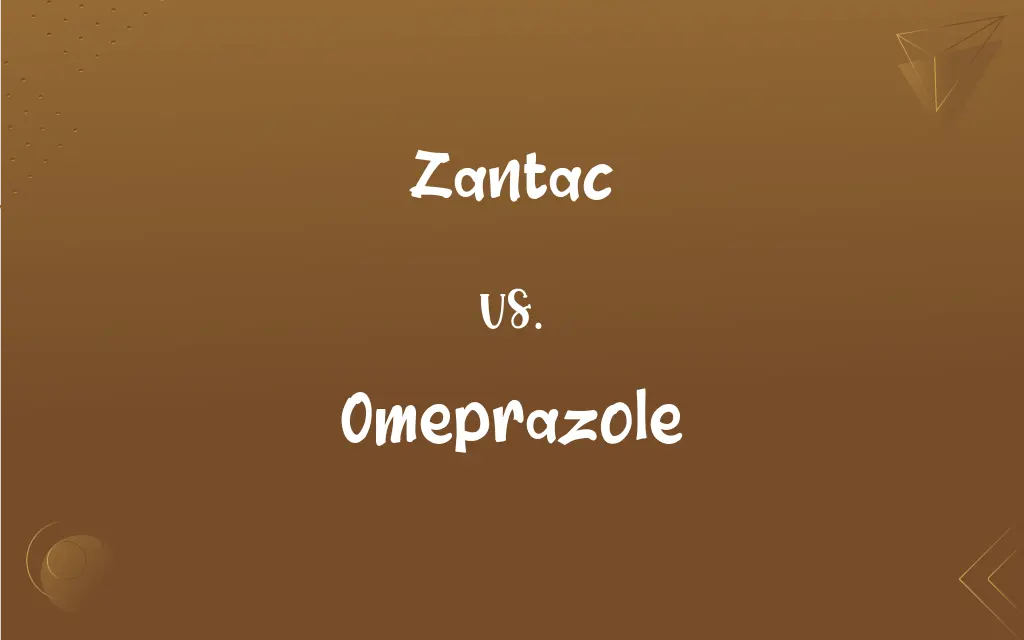Zantac vs. Omeprazole: What's the Difference?
Edited by Janet White || By Harlon Moss || Updated on October 11, 2023
Zantac (ranitidine) and Omeprazole both reduce stomach acid, but Zantac is an H2 blocker and Omeprazole is a proton pump inhibitor.

Key Differences
Zantac is a brand name for ranitidine, which belongs to a class of drugs known as H2 blockers. Zantac operates by reducing the amount of acid produced in the stomach, thereby alleviating symptoms related to acid reflux and preventing damage to the lower esophagus caused by stomach acid. It was widely used to treat heartburn and indigestion among other acid-related disorders. However, it is worth noting that Zantac has been recalled in several countries due to concerns about potential contaminants.
On the other side, Omeprazole is a generic name for a drug that is a proton pump inhibitor (PPI). The mechanism by which Omeprazole works involves directly blocking the proton pump in the stomach lining. This pump is responsible for secreting hydrochloric acid into the stomach. By inhibiting this pump, Omeprazole is able to significantly reduce acid production, thereby providing relief from symptoms and facilitating healing in acid-related disorders of the digestive tract.
While both Zantac and Omeprazole are geared towards reducing stomach acid, they take different approaches in achieving this goal. Zantac, as an H2 blocker, prevents histamine from activating the proton pump, thereby indirectly reducing acid production. It typically acts more quickly than PPIs to reduce acid and alleviate symptoms, but its effects might not be as long-lasting.
Omeprazole, on the other hand, directly inhibits the proton pump itself, thereby providing a more direct and potent inhibition of acid secretion. It might take a little longer to exhibit its effects when compared to H2 blockers like Zantac, but the duration of the acid-suppressive effect is longer. Omeprazole is often recommended for individuals requiring more sustained acid suppression, such as those with gastroesophageal reflux disease (GERD).
It is also pertinent to mention that while both drugs have their benefits in managing acid-related conditions, they can have different side effect profiles and drug interactions. While Zantac may have interactions with drugs like warfarin, procainamide, and certain antifungals, Omeprazole may interact with drugs like diazepam, blood thinners, and digoxin. Health professionals often consider these factors when prescribing either Zantac or Omeprazole to ensure safe and effective management of acid-related disorders.
ADVERTISEMENT
Comparison Chart
Drug Class
H2 Blocker
Proton Pump Inhibitor (PPI)
Mechanism of Action
Reduces acid by blocking histamine
Directly inhibits proton pump
Onset of Action
Typically acts faster than PPIs
May take longer to act but has longer-lasting effects
Primary Use
Heartburn, indigestion, and acid reflux
GERD and more sustained acid suppression needs
Noteworthy Interactions
May interact with warfarin and procainamide
Can interact with diazepam and blood thinners
ADVERTISEMENT
Zantac and Omeprazole Definitions
Zantac
Zantac was used to treat various conditions, including peptic ulcers and gastroesophageal reflux disease (GERD).
Physicians would often recommend Zantac to patients experiencing frequent acid reflux.
Omeprazole
It is commonly used to treat conditions like heartburn, acid reflux, and peptic ulcers.
Omeprazole can provide relief from the burning sensation of heartburn.
Zantac
Notably, Zantac is the brand name for the generic drug ranitidine.
Though Zantac was once popular, the production was halted due to concerns about contaminants.
Omeprazole
Omeprazole is a proton pump inhibitor utilized to decrease stomach acid.
Many patients take omeprazole to manage their gastroesophageal reflux disease (GERD).
Zantac
Zantac is a medication, specifically an H2 blocker, used to decrease acid production in the stomach.
Zantac was commonly prescribed to alleviate heartburn symptoms before its recall.
Omeprazole
Omeprazole works by directly inhibiting proton pumps in the stomach lining.
By reducing acid through omeprazole, patients often find relief from persistent indigestion.
Zantac
Zantac acts by inhibiting the action of histamine on stomach cells, thus reducing acid production.
Through decreasing stomach acid, Zantac could prevent damage to the esophagus from acid reflux.
Omeprazole
The medication omeprazole can also be utilized in healing erosive esophagitis.
Doctors may prescribe omeprazole to facilitate healing in patients with damage to their esophagus from stomach acid.
Zantac
The drug Zantac has faced recalls and has been under scrutiny due to the detection of a possible carcinogen.
Owing to safety concerns, many patients switched from Zantac to alternative medications for acid control.
Omeprazole
Omeprazole can be available in different forms such as capsules, tablets, and even in a liquid form.
The doctor recommended taking omeprazole capsules half an hour before meals to effectively manage acid production.
Zantac
A histamine blocker and antacid (trade name Zantac) used to treat peptic ulcers and gastritis and esophageal reflux
Omeprazole
A proton pump inhibitor drug, C17H19N3O3S, that suppresses gastric acid secretion and is used for the treatment of duodenal and gastric ulcers and gastroesophageal reflux disease.
Omeprazole
(pharmaceutical drug) A substituted benzimidazole (trademark Losec, Prilosec) which is a proton pump inhibitor and inhibits secretion of gastric acid, being given orally in the treatment of ulcers and gastroesophageal reflux; 5-methoxy-2-(4-methoxy-3,5-dimethyl-2-pyridylmethylsulfinyl)benzimidazole, C17H19N3O3S.
Omeprazole
Antacid (trade name Prilosec) that suppresses acid secretion in the stomach
FAQs
What is Zantac used for?
Zantac is used to reduce stomach acid and treat conditions like heartburn and acid reflux.
How does Zantac work?
Zantac works by inhibiting the action of histamine on stomach cells, reducing acid production.
What conditions is omeprazole used to treat?
Omeprazole is used to treat conditions like GERD, heartburn, and peptic ulcers.
Which is better for immediate heartburn relief: Zantac or omeprazole?
Zantac may act faster for immediate relief, but for ongoing management, the choice between them should be based on a healthcare provider's recommendation.
Why was Zantac recalled?
Zantac was recalled due to concerns about a potential carcinogen, N-nitrosodimethylamine (NDMA), found in the medication.
Is omeprazole available over the counter?
Yes, omeprazole is available both over the counter in lower strengths and by prescription in higher strengths.
How long does it take for omeprazole to work?
Omeprazole may take a few days to reduce stomach acid and up to four weeks to heal an inflamed esophagus.
What is the main ingredient in Zantac?
Ranitidine is the main ingredient in Zantac.
Is omeprazole a proton pump inhibitor?
Yes, omeprazole is classified as a proton pump inhibitor.
Can Zantac be used to treat allergies?
Zantac has been used off-label to treat allergies due to its ability to block histamine, but this is not its primary indication.
What should I avoid while taking Zantac?
Avoid consuming substances that can irritate your stomach like alcohol, caffeine, and spicy foods while taking Zantac.
Can omeprazole cause side effects?
Yes, omeprazole can cause side effects such as headache, nausea, vomiting, and diarrhea in some individuals.
How fast does Zantac provide relief?
Zantac can start reducing acid within 30 minutes to an hour.
Can I take Zantac and omeprazole together?
It is important to consult a healthcare provider for advice on combining medications, as combining Zantac and omeprazole might not be commonly recommended due to their similar effects.
Can I drink alcohol while taking omeprazole?
It's generally considered safe to drink alcohol in moderation while taking omeprazole, but it's best to consult with a healthcare provider.
Are there alternatives to Zantac and omeprazole for reducing stomach acid?
Yes, there are several alternatives like famotidine, lansoprazole, and esomeprazole, but it's essential to consult a healthcare provider for the best option for your condition.
Can I still buy Zantac?
Availability of Zantac may vary due to recalls, with alternative ranitidine products or different medications being offered instead.
How should omeprazole be taken?
Omeprazole is commonly taken before meals, often in the morning, to effectively control stomach acid throughout the day.
What is the difference between Zantac and omeprazole?
Zantac is an H2 blocker while omeprazole is a proton pump inhibitor; they reduce stomach acid through different mechanisms.
Can omeprazole be used long term?
Long-term use of omeprazole should be under a healthcare provider's supervision due to potential risks and side effects.
About Author
Written by
Harlon MossHarlon is a seasoned quality moderator and accomplished content writer for Difference Wiki. An alumnus of the prestigious University of California, he earned his degree in Computer Science. Leveraging his academic background, Harlon brings a meticulous and informed perspective to his work, ensuring content accuracy and excellence.
Edited by
Janet WhiteJanet White has been an esteemed writer and blogger for Difference Wiki. Holding a Master's degree in Science and Medical Journalism from the prestigious Boston University, she has consistently demonstrated her expertise and passion for her field. When she's not immersed in her work, Janet relishes her time exercising, delving into a good book, and cherishing moments with friends and family.































































